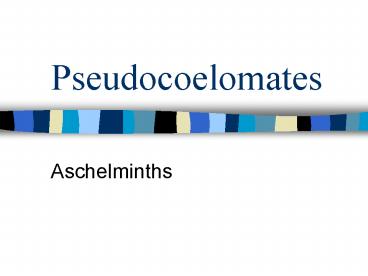Pseudocoelomates - PowerPoint PPT Presentation
Title:
Pseudocoelomates
Description:
Pseudocoelomates Aschelminths Achelminth Phyla Gastrotricha Rotifera Kinorhyncha Nematoda Nematomorpha Acanthocephala Loricifera Priapulida Entoprocta ... – PowerPoint PPT presentation
Number of Views:86
Avg rating:3.0/5.0
Title: Pseudocoelomates
1
Pseudocoelomates
- Aschelminths
2
Achelminth Phyla
- Gastrotricha
- Rotifera
- Kinorhyncha
- Nematoda
- Nematomorpha
- Acanthocephala
- Loricifera
- Priapulida
- Entoprocta
3
Pseudocoelomates
- Define pseudocoelomate.
- formed directly from the cavity of the blastula
- The cavity is small
- Mostly filled with intestine and oviducts or
testes.
4
Gastrotricha
- Microscopic
- Marine and freshwater species
- Common in lakes, ponds and seashore sands
5
Rotifera
- Ciliated crown or corona at the anterior end
- Carnivorous or parasitic
- Most common in freshwater environments
- Body structure
- Head has corona
- Trunk has ridged plates and spines
- Foot has toes for attachment.
6
Rotifera
7
Kinorhyncha
- About 150 species
- Lives in marine sediment
- Uses head as an anchor, pulls body after it.
- Sexes are separate
- Feed on algae and bacteria
8
Nematodes
- bilaterally symmetrical
- worm-like
- surrounded by a cuticle secreted by epidermal
cells - longitudinal muscles only
9
Nervous System - Nematodes
- Simple ring of nervous tissue around pharynx
- dorsal and ventral nerve cords running the length
of the body
10
Nematode Movement
- Contract longitudinal muscles
- High internal pressure causes the body to flex
- Moves by thrashing back and forth
- No cilia or flagella
11
Excretory Systems
- Some have specialized cells that excrete
nitrogenous wastes - Others have canals
- Others have canals plus specialized cells
- Nematodes do not have flame cells
12
Nematode Reproduction
- Most nematodes are dioecious
- Males use special copulatory spines
- The sperm move by pseudopodia, like amoebas
13
Nematode Diversity
- Close to 500,000 species
- Some species are generalists
- Others are much more specialized -
- one species of nematode is known only from felt
coasters placed under beer mugs in a few towns in
Germany.
14
Nematode Lifestyles
- Many free living
- Many also parasitic
- Play critical ecological roles as decomposers and
predators on microorganisms
15
Nematode-Caused Diseases
- Roundworms - more than ½ the world's humans
- Hookworms
- Trichinosis
- Pinworms infestations - extremely common parasite
in the United States - can be transmitted from human to human by eggs
floating in household dust - Filariasis (elephantiasis)
- Onchocerciasis (river blindness).
16
Nematomorpha Horsehair Worms or Gordian Worms
- Up to 1m long, but very slender animals (1-3mm).
- Free-living as adults
- Often find adults in very clean streams
17
Juveniles are Arthropod Parasites
18
Acanthocephala - spiny headed worms
- 2-host parasites
- Must have invertebrate host
- Spiny protrusible proboscis
- About 1150 species
- Dioecious
- Both circular and longitudinal muscles
19
Acanthocephalans - Nutrition
- Nutrition by diffusion
- Proboscis attaches to host intestine
- Cause extensive damage to the intestinal walls
- Economic importance Some forms cause serious
discomfort and ill-health to domestic livestock
20
Excretion
- Protonephridia lined with flame cells
Reproduction
- Reproductive structures are contained in strange
ligament sacs. - In males two testes are contained within this
sheath.
21
Loricifera
- Discovered in 1974
- Dioecious
- Have a large brain
- Little else is known about them.
22
Priapulida The Penis Worms
- Only 9 species
- All marine worms
- Found in colder water
- Predaceous
- Fossils date back to Middle Cambrian.
23
Entoprocta (Bryozoa)
- Ciliary feeding device - LOPHOPHORE
- Were known as Bryozoa (moss animals)
- 4000 species
- Few gt 0.5 mm long
- All aquatic (marine and freshwater)
24
Ectoproct Feeding
25
Entoprocta
- Most are colonial
- Lives in secreted exoskeleton (zoecium) that may
be - Gelatinous
- Chitinous
- Stiffened with calcium
- Impregnated with sand.
- Some ectoprocts could be mistaken for hydroids
but their tentacles are ciliated.
26
Ectoproct Colony






























